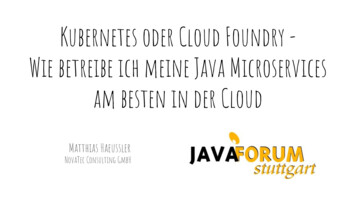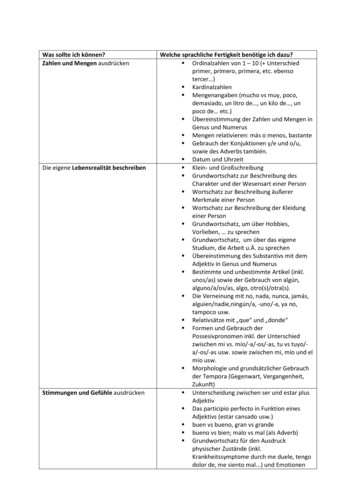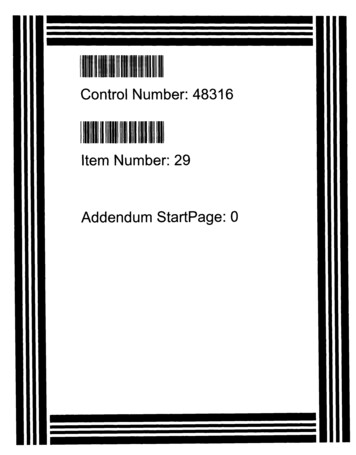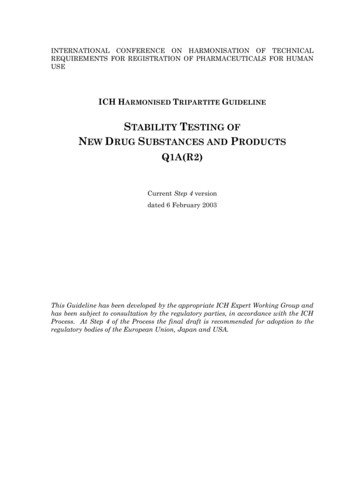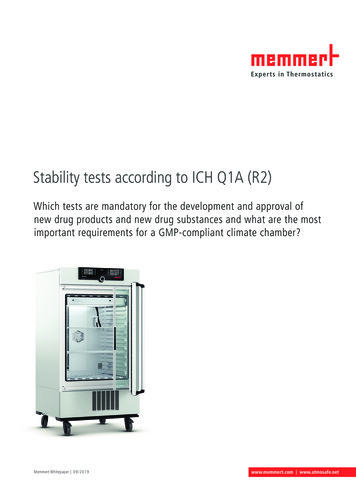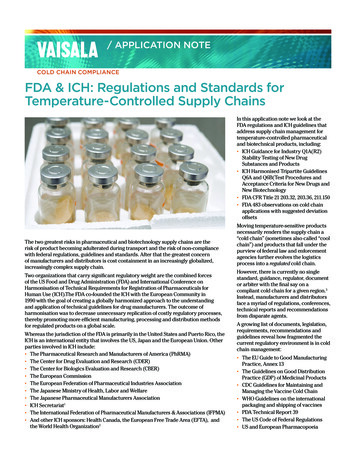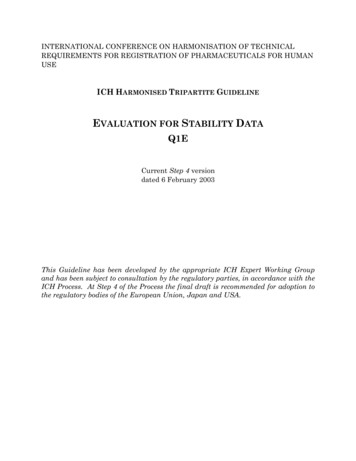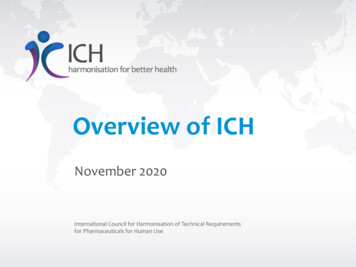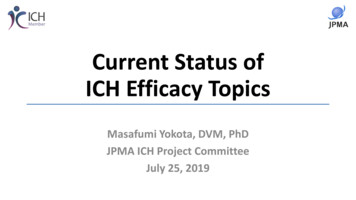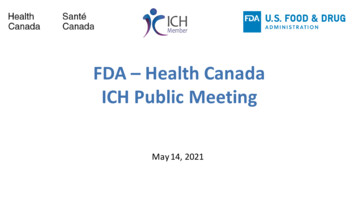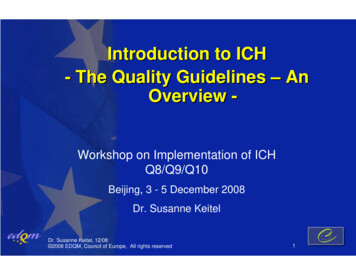
Transcription
Introduction to ICH- The Quality Guidelines – AnOverview -Workshop on Implementation of ICHQ8/Q9/Q10Beijing, 3 - 5 December 2008Dr. Susanne KeitelDr. Susanne Keitel, 12/08 2008 EDQM, Council of Europe, All rights reserved1
The “Q-Family”Q 1 – Stability TestingQ 2 – Analytical ValidationQ 3 – ImpuritiesQ 4 – PharmacopoeiasQ 5 – Biotechnological ProductsQ 6 – SpecificationsQ 7 – Good Manufacturing PracticesQ 8 – Pharmaceutical DevelopmentQ 9 – Quality Risk ManagementQ 10 – Pharmaceutical Quality SystemDr. Susanne Keitel, 12/08 2008 EDQM, Council of Europe, All rights reserved2
ICH Q 1 – Stability TestingA set of originally five guidelines (Q1A to Q1F)defining- General aspects of stability testing (storageconditions, batch size and number, length oftime.)- Photostability- Application to new dosage forms- Possibilities for reduced test designs(bracketing and matrixing)Dr. Susanne Keitel, 12/08 2008 EDQM, Council of Europe, All rights reserved3
ICH Q 1 – Stability Testing- Statistical evaluation of stability dataand possibilities for extrapolation- Storage conditions for stability testing inclimatic zones III and IV (withdrawn)Dr. Susanne Keitel, 12/08 2008 EDQM, Council of Europe, All rights reserved4
ICH Q 1 A (R2) – Scope- For new API and related medicinal products- To provide evidence on how the quality of anAPI/finished product changes with time underthe influence of environmental factors suchas temperature, humidity and light and toestablish a re-test period/shelf-life for theAPI/finished productDr. Susanne Keitel, 12/08 2008 EDQM, Council of Europe, All rights reserved5
ICH Q 1 A (R2) – In a Nutshell.- Stress testing required for API- Long-term and accelerated testing required for API andproduct, where necessary intermediate testing- Minimum of three representative batches- Testing over a minimum of 12 months at LT and 6 months ataccelerated conditions (with defined testing frequency)- Storage conditions for the “general case”, aqueous productsin semi-permeable containers, products to be stored in arefrigerator and a freezer- Stability commitmentDr. Susanne Keitel, 12/08 2008 EDQM, Council of Europe, All rights reserved6
ICH Q 1 B – In a Nutshell.- Describes requirements on photostability testing and defineslight exposure to be applied- To be tested on API – if not photosensitive, no further testingrequired- If photosensitive, to be continued on exposed finishedproduct and product in primary package, product inmarketing package, where relevant- Where necessary, impact of light during manufacturingprocess to be evaluated- Confirmatory testing required, where applicableDr. Susanne Keitel, 12/08 2008 EDQM, Council of Europe, All rights reserved7
ICH Q 1 C – In a Nutshell.- Additional guidance to ICH Q1 A(R2) on newdosage forms (“line extensions”) for newsubstances- Reduced requirements as regards time to becovered at LT storage conditions at time of dossiersubmissionsDr. Susanne Keitel, 12/08 2008 EDQM, Council of Europe, All rights reserved8
ICH Q 1 D – In a Nutshell.- Describes possibilities to apply reduced test designs, i.e.bracketing and matrixing- Defines situations where reduced testing can be appliedwithout additional justification, with justification or where it isnot applicable- Bracketing: testing of extremes only- Matrixing: testing of a different samples of factorcombinations at different time points during the study- Provides example designsDr. Susanne Keitel, 12/08 2008 EDQM, Council of Europe, All rights reserved9
Example of Bracketing DesignBracketing on strength and container sizeStrength50 mgBatch123TTContainer100 mlsize500 ml TT15 mlDr. Susanne Keitel, 12/08 2008 EDQM, Council of Europe, All rights reserved75 mg12100 mg3123TTTTTTTT10
Example of Matrixing DesignTwo strengths, matrixing on time pointTime point (months)StrengthS1S2036Batch 1TTBatch 2TTBatch 3TTBatch 1TTBatch 2TTBatch 3TT912TTTT182436TTTTT(T)TTTT(T)TTTTTTTTTTTT: Sample tested; (T): Sample tested if full shelf life data will not beavailable before approval.Dr. Susanne Keitel, 12/08 2008 EDQM, Council of Europe, All rights reserved11
ICH Q 2 – Analytical ValidationA guideline defining the validationparameters needed for a variety ofanalytical methods and describingcharacteristics to be considered for thevalidation of analytical proceduresincluded in a marketing authorisationdossierDr. Susanne Keitel, 12/08 2008 EDQM, Council of Europe, All rights reserved12
ICH Q 2 – . In a Nutshell-Defines criteria for the validation of the fourmost common types of analytical procedures:identification testsquantitative tests for impuritieslimit tests for the control of impuritiesquantitative tests for the active moiety in APIor finished product or or other selectedcomponents in the productDr. Susanne Keitel, 12/08 2008 EDQM, Council of Europe, All rights reserved13
ICH Q 2 – . In a NutshellDefines typical analytical validationcharacteristics, to which tests to apply themand examples on the “how to”- Accuracy- Precision- Repeatability- Intermediate Precision-SpecificityDetection LimitQuantitation LimitRangeDr. Susanne Keitel, 12/08 2008 EDQM, Council of Europe, All rights reserved14
Typical Validation tionTesting for ImpuritiesquantitativelimitAssayAccuracy- - PrecisionRepeatabilityInt. Precision- - Specificty Detection Limit-- -Quant. Limit.- --Linearity- - Range- - Dr. Susanne Keitel, 12/08 2008 EDQM, Council of Europe, All rights reserved15
ICH Q 3 – ImpuritiesA set of three guidelines addressing thechemistry and safety aspects of impurities,including the listing of impurities inspecifications. Defines the thresholds forreporting, identification and qualification ofimpurities in API and finished product.Specific guideline on residual solventsDr. Susanne Keitel, 12/08 2008 EDQM, Council of Europe, All rights reserved16
ICH Q 3 A(R) – in a NutshellClassifies impurities- organic impurities Starting materialsBy-productsInermediatesDegradation productsReagents, ligants, catalysts- Inorganic impurities Reagents, liegands, catalystsHeavy metals or other residual metalsInorganic saltsOther impurities, e.g. filter aids, charcoal - Residual solventsDr. Susanne Keitel, 12/08 2008 EDQM, Council of Europe, All rights reserved17
ICH Q 3 A(R) – in a NutshellDefines rationale for the reporting and control ofimpurities as well as requirements for listingimpurities in specifications: Organic Impurities- Each specified identified impurity- Each specified unidentified impurity- Any unspecified impurity with acceptance criterion of NMT theidentification threshold Residual solvents Inorganic impuritiesDr. Susanne Keitel, 12/08 2008 EDQM, Council of Europe, All rights reserved18
ICH Q 3 A(R) – in a NutshellDefinitionsIdentified impurity: . impurity for which a structural characterisationhas been achievedQualification: .is the process of acquiring and evaluating datathat establishes the biological safety of an individualimpurity or a given impurity profile at the level(s)specified.Dr. Susanne Keitel, 12/08 2008 EDQM, Council of Europe, All rights reserved19
ICH Q 3 A(R) – in a NutshellDefinitionsSpecified impurity: impurity that is individually listed and limited with aspecific acceptance criterion in the specification. Can beeither identified or unidentified.Unidentified impurity: impurity for which a structural characterisation has notbeen achieved and that is solely defined by qualitativeanalytical properties, e.g. chromatographic retention timeUnspecified impurity: impurity that is limited by a general acceptance criterion,but not individually listed with its own specific acceptancecriterion in the specificationDr. Susanne Keitel, 12/08 2008 EDQM, Council of Europe, All rights reserved20
Thresholds for Impurities in APIMaximumDaily DoseReportingThreshold 2 g/day0.05 % 2 g/day0.03 %IdentificationThreshold0.10 % or 1.0 mg/day(whichever is lower)QualificationThreshold0.15 % or 1.0mg/day(whichever is lower)0.05 %0.05 % number of decimal digits: two below 1.0 %, one above 1.0 % application of conventional rounding rules total impurities reporting thresholdDr. Susanne Keitel, 12/08 2008 EDQM, Council of Europe, All rights reserved21
Thresholds of Impurities in Finished ProductsExample 15 mg/dayReporting threshold0.1 %Identification threshold 0.5%/20 µg TDIQualifcation thresholdDr. Susanne Keitel, 12/08 2008 EDQM, Council of Europe, All rights reserved0.5%/200µg TDI22
ICH Q 3 C – in a NutshellRecommends acceptable amounts forresidual solvents in pharmaceuticals for thesafety of patients, recommends use of lesstoxic solvents and describes levelsconsidered to be toxicologically acceptablefor some solvents. Non-exhaustive list ofsolvents included in the guideline as annex.Dr. Susanne Keitel, 12/08 2008 EDQM, Council of Europe, All rights reserved23
Classification of Residual SolventsClass I solvents to be avoidedClass IIKnown human carcinogens, stronglysuspected human carcinogens, andenvironmental hazardsNon-genotoxic animal carcinogens or possiblecausative agents of other irreversible toxicity.Solvents suspected of other significant butreversible toxicities solvents to be limitedSolvents with low toxic potential to man;no health-based exposure limit is neededClass III solvents with low toxic potentialDr. Susanne Keitel, 12/08 2008 EDQM, Council of Europe, All rights reserved24
Classification of Residual SolventsBenzene, carbon tetrachloride,Class I solvents to be avoidedClass II1,2-dichloroethane, 1,1-dichloroethene, 1,1,1trichloroethaneAcetonitrile, chloroform, cyclohexane,dioxane, methanol, methylbutylketone,tetrahydrofurane, toluene, . solvents to be limitedClass IIIAcetone, butanol, butyl acetate, DMSO, ethanol,ethyl acetate, ethyl ether, heptane, isopropanol,methylethyl ketone, . solvents with low toxic potentialDr. Susanne Keitel, 12/08 2008 EDQM, Council of Europe, All rights reserved25
ICH Q3 C – in a NutshellDefines options for the definition of acceptance criteriafor class 2 solventsOption 1 tabulated limits,calculated on the basis of a TDI of 10 g of the productOption 2 not all individual components of a product have to complywith the tabulated limits – the total content of the solventhas to be below the permitted daily intake (PDE)Dr. Susanne Keitel, 12/08 2008 EDQM, Council of Europe, All rights reserved26
ICH Q3 C – in a NutshellExample for option 2Concentration 1000 x PDEDoseComponentAmount inFormulationContentAcetonitril *Daily IntakeAPI0.3 g800 ppm0.24 mgExcipient 10.9 g400 ppm0.36 mgExcipient23.8 g800 ppm3.04 mgProduct5.0 g728 ppm3.64 mg9* PDE: 4.1 mg/day, limit: 410 ppmDr. Susanne Keitel, 12/08 2008 EDQM, Council of Europe, All rights reserved27
ICH Q 4 – PharmacopoeiasHarmonisation of 10 general methodsreferred to in the ICH specification guidelineICH Q 6A is undertaken by thePharmacopoeial Discussion Group (PDG).ICH Q4 B evaluates selected pharmacopoeialtexts to facilitate their recognition byregulatory authorities as interchangeable inthe ICH region. Adopts specific annexes forthe different texts.Dr. Susanne Keitel, 12/08 2008 EDQM, Council of Europe, All rights reserved28
ICH Q 5 – BiotechnologicalProductsA set of five guidelines defining requirementson various specifics for biotechnologicalproducts:- viral safety- Analysis of the expression construct in cellsused for production of r-DNA derived proteinproducts- Stability testingDr. Susanne Keitel, 12/08 2008 EDQM, Council of Europe, All rights reserved29
ICH Q 5 – BiotechnologicalProducts- Derivation and characterisation of cellsubstrates- Comparability ofbiotechnological/biological productssubject to changes in the manufacturingprocessDr. Susanne Keitel, 12/08 2008 EDQM, Council of Europe, All rights reserved30
ICH Q 6 – SpecificationsTwo guidelines addressing the selectionof tests and methods and settingspecifications for quality control of APIand finished products (chemicals andbiotechnologically derived proteins andpolypeptides)Dr. Susanne Keitel, 12/08 2008 EDQM, Council of Europe, All rights reserved31
ICH Q 6A – . In a NutshellIntended to assist in the establishmentof a single set of global specifications forAPI and finished product. Providesguidance on the setting and justificationof acceptance criteria and the selectionof test procedures.Dr. Susanne Keitel, 12/08 2008 EDQM, Council of Europe, All rights reserved32
ICH Q 6A – . In a NutshellSpecification: . A list of tests, references to analyticalprocedures and appropriate acceptancecriteria, which are numerical limits, ranges orother criteria for the tests described.Establishes the set of criteria to be met inorder to be considered “acceptable forintended use”. “Conformance to specification” means thatthe API/product will meet the acceptancecriteria WHEN testedDr. Susanne Keitel, 12/08 2008 EDQM, Council of Europe, All rights reserved33
ICH Q 6A – . In a NutshellSpecifications (cont.): . Are proposed/justified by applicant and approvedby regulatory authorities as conditions of approval . Are one part of a total control strategy for theAPI/product. Other parts or this strategy includethorough product characterisation duringdevelopment and adherence to GMP (!!) are chosen to confirm the quality rather than toestablish full characterisation, should focus onthose characteristics useful in ensuring the safetyand efficacy of the product.Dr. Susanne Keitel, 12/08 2008 EDQM, Council of Europe, All rights reserved34
ICH Q 6A – . In a NutshellDefines general concepts, e.g.-Periodic or skip testingRelease vs. shelf-life acceptance criteriaIn-process testsDesign and development considerationsLimited data available at filingParametric releaseAlternative proceduresPharmacopoeial tests and acceptance criteriaEvolving technologiesImpact of API on product specificationsReference standardDr. Susanne Keitel, 12/08 2008 EDQM, Council of Europe, All rights reserved35
ICH Q 6A – . in a NutshellDefines universal tests/criteria for- API- Finished productDefines additional specific tests/criteria for- API- Finished product¾ Solid oral dosage forms¾ Oral liquids¾ Parenteral drug productsDr. Susanne Keitel, 12/08 2008 EDQM, Council of Europe, All rights reserved36
Universal Tests/Criteria - APIDescriptionIdentification specific for the substance (e.g.: IR, HPLC/UV (DAD),HPLC/MS, GC/MS)Assay specific / stability indicating procedureoften possible to use method that is also used forquantification of impurities (e.g. HPLCImpurities (organic, inorganic, residual solvents) specific /stability-indicating procedure Decision tree # 1 on extrapolation of meaningful limitsDr. Susanne Keitel, 12/08 2008 EDQM, Council of Europe, All rights reserved37
Universal Tests/Criteria - ProductDescriptionIdentification specific (IR, HPLC/UV (DAD),HPLC/MS, GC/MS)Assay specific / stability-indicating procedure(z.B. HPLC, which is also used for impurities quantification,where applicable, results of content uniformity test can be used)Impurities (organic, inorganic, residual solvents) specific /stability-indicating procedure: degradation products andimpurities arising during the manufacturing process Decision tree #2 on extrapolation of meaningful limitsDr. Susanne Keitel, 12/08 2008 EDQM, Council of Europe, All rights reserved38
Examples of Specific Tests/Criteria - APIPhysicochemical properties pH, melting point/range, refractive index .Particle size API in solid or suspension drug productsDecision tree #3Polymorphic forms crystalline forms. Solvates, hydratesthermal analysis (DSC, DTA), IR, microscopy, X-raypowderrdiffraction, . For the finished product normally dissolutionas surrogate parameter Decision tree #4(1)-4(3)Dr. Susanne Keitel, 12/08 2008 EDQM, Council of Europe, All rights reserved39
Examples of Specific Tests/Criteria – Solid OralDosage FormsDissolution in-vitro-release of active from the product.single point-measurement for immediate release productsmultiple time point sampling for extended release, two-stage testingfor delayed release dosage forms Decision tree # 7 (1-3)Disintegration may be substituted for dissolution for rapidly dissolving prodcutscontaining active which is highly soluble throughout the physiologicalrangeDr. Susanne Keitel, 12/08 2008 EDQM, Council of Europe, All rights reserved40
ICH Q 7 – GMP for APIA guideline defining GMP requirementsfor the manufacture of API – based onexisting regional and international(PIC/S) guidance, elaborated jointly withrepresentatives from the generic andself-medication industry, PIC/S,Australia, India and ChinaDr. Susanne Keitel, 12/08 2008 EDQM, Council of Europe, All rights reserved41
ICH Q 7 - . In a Nutshell-IntroductionQuality ManagementPersonnelBuildings and FacilitiesProcess EquipmentDocumentation and RecordsMaterials ManagementProduction and In-Process ControlsDr. Susanne Keitel, 12/08 2008 EDQM, Council of Europe, All rights reserved42
ICH Q 7 - . In a Nutshell- Packaging and Identification / Labelling ofAPIs and Intermediates- Storage and Distribution- Laboratory Controls- Validation- Change Control- Rejection and Re-Use of Material- Complaints and RecallsDr. Susanne Keitel, 12/08 2008 EDQM, Council of Europe, All rights reserved43
ICH Q 7 - . In a Nutshell- Agents, Brokers, Traders, Distributors,Repackers and Relabellers- Specific Guidance for APIsmanufactured by CellCulture/Fermentation- APIs for Clinical Trials- GlossaryDr. Susanne Keitel, 12/08 2008 EDQM, Council of Europe, All rights reserved44
ICH M4 Q – CommontTechnical Document defines a common format for themarketing authorisation application in the ICHregion, BUT addresses only format/structure,not the specific requirementsCTD merely indicates the location whereinformation has to be providedDr. Susanne Keitel, 12/08 2008 EDQM, Council of Europe, All rights reserved45
Submission of the DossierStructure ofthe CommonTechnicalDocument(CTD)Dr. Susanne Keitel, 12/08 2008 EDQM, Council of Europe, All rights reserved46
Module 2: Overviews andsummaries2.12.22.32.42.52.62.7CTD TOC Modules 2-5IntroductionQuality Overall SummaryNonclinical OverviewClinical OverviewNonclinical SummaryClinical SummaryDr. Susanne Keitel, 12/08 2008 EDQM, Council of Europe, All rights reserved47
Module 3: QualityGeneral Structure/Drug Substance3.2 S3.2 S13.2 S23.2 S33.2 S43.2 S53.2 S63.2 S7Drug SubstanceGeneral InformationManufactureCharacterisationControl of Drug SubstanceReference Standards or MaterialsContainer Closure SystemStabilityDr. Susanne Keitel, 12/08 2008 EDQM, Council of Europe, All rights reserved48
General Structure/Drug Product3.2 P3.2 P13.2 P23.2 P33.2 P43.2 P53.2 P63.2 P73.2 P8Drug ProductDescription and Composition of the DrugProductPharmaceutical DevelopmentManufactureControl of ExcipientsControl of Drug ProductReference Standards or MaterialsContainer Closure SystemStabilityDr. Susanne Keitel, 12/08 2008 EDQM, Council of Europe, All rights reserved49
General Structure/Appendices etc.AAppendicesA1 Facilities and EquipmentA2 Adventitous Agents Safety EvaluationRRegional InformationCKey Literature ReferencesDr. Susanne Keitel, 12/08 2008 EDQM, Council of Europe, All rights reserved50
Thank you!
A set of originally five guidelines (Q1A to Q1F) defining - General aspects of stability testing (storage conditions, batch size and number, length of time.) - Photostability . ICH Q 1 A (R2) – Scope - For new API and related medicina
